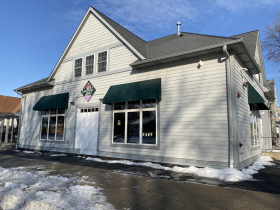Halyard Park Has a Suburban Feel
It’s a neighborhood transformed, with new houses from 1970s and ‘80s, along with restored Victorian homes.
Distance: One-and-a-half miles
Start: At the corner of W. Walnut St. and N. Vel R. Phillips Ave.
Parking: On the street
Halyard Park, adjoining the Bronzeville area, is a neighborhood of middle-class homes that could be easily confused with Fox Point, Glendale, or Brown Deer. It’s also a testimony to the vision of Ardie Clark Halyard and her husband Wilbur who played a vital role in the redevelopment of the area in the 1970s.
In 1924, a year after they came to Milwaukee from Beloit, the Halyards founded the first Black-owned bank in Milwaukee with the goal of helping black residents secure loans for homes. This was during a period when redlining was prevalent, a policy that kept Black families out of more desirable neighborhoods and segregated them into neighborhoods that lending institutions considered riskier and were less likely to finance home loans. Halyard Park, bounded by North Avenue, Dr. Martin Luther Jr. King Drive, Walnut Street, and 6th Street, was a neighborhood that was redlined.
In the early 1900s, the German families left the area and were replaced by a mix of Italians, Poles, African Americans, and Eastern European Jews, including Goldie Mabowehz who emigrated from what is now Belarus. We now know her as Golda Meir, Israel’s Prime Minister from 1969-1974.
In the 1960s the I-43 freeway tore through the heart of what was by then a mostly Black neighborhood. Many homes were demolished and the neighborhood began to decline, including the once-booming retail area on Walnut Street. In 1972, the Halyard Renewal Area was established, five blocks between Vel R. Phillips Avenue to the east, 6th Street on the west, Brown Street to the south, and Garfield Avenue to the north. Most of the homes in the area were demolished to make room for the the construction of new, middle-class homes for Black residents. This redevelopment was spearheaded by United Realty Group and Beechie Brooks, a realtor and community leader along with Ardie and Wilbur’s Savings and Loan Company. In 1977, Brooks built the first home in Halyard Park for his family and by the end of the 1980s, a new neighborhood was complete, with 43 middle-class homes.
It was a community of single-family homes with attached garages and amenities such as interior fireplaces. New life had come to this formerly blighted neighborhood where today residents enjoy suburban comforts while living in the middle of Milwaukee. To continue this rebirth, many of the homes north of Walnut and south of Brown that remained intact have been renovated, some of them lovely three-story Victorians from the early 1900s.
The Walk
Start walking at the corner of Vel R. Phillips and Walnut where you will see at 1702 the first home of Mount Sinai Hospital. Before the building housed the hospital it was a hotel and before the hotel it was a boarding house run by brewer, Emmanual Burgy. Further north on Vel R. Phillips, the St. Francis of Assisi Roman Catholic Church is located on the site of a frame church built by Capuchin monks in 1869. The current building replaced the wooden frame building and in 1900 the lovely carved limestone entrance was added.
After you cross Brown, you enter the Halyard Renewal Area where the homes would fit into the northern suburbs with one notable difference, this neighborhood has sidewalks. The streets are quiet, peaceful, yet city sounds, traffic, sirens, and the “beep beep” of large equipment backing up, seep into this mid-city oasis where basketball hoops and late model cars are part of the landscape.
At Garfield turn left and walk past Garfield’s 502, a neighborhood bar and restaurant where live music and southern cuisine are on the menu. Turn left at 6th Street and continue to Gaines Triangle, a park dedicated to Lincoln and Marie Gaines to honor their years of community service to youth in Milwaukee. The fountain located in Gaines Triangle appears on the Halyard Park neighborhood signs.
Return to Garfield, turn right on 5th Street and continue south to Walnut. Turn left on Walnut and return to start.
Along this walk the differences between the homes in the Halyard Renewal Area and homes south of Brown clearly delineate the old and the new. Many Victorian homes south of Brown have been restored, in contrast to the newer homes built in the 1970s, which makes Halyard Park a fascinating study in diverse approaches to urban renewal. When passion and determination are present, a neighborhood can be transformed, like a phoenix rising from the ashes.
Along the Walk
Cari Taylor-Carlson is the author of Milwaukee Walks: 20 Choice Walks in a Classy City.
If you think stories like this are important, become a member of Urban Milwaukee and help support real, independent journalism. Plus you get some cool added benefits.
Milwaukee Walks
-
Kilbourntown Tour Offers Tons of History
 Oct 8th, 2023 by Cari Taylor-Carlson
Oct 8th, 2023 by Cari Taylor-Carlson
-
Riverwest Is a Melting Pot
 Aug 25th, 2023 by Cari Taylor-Carlson
Aug 25th, 2023 by Cari Taylor-Carlson
-
Layton Boulevard Has Overlooked History
 Jul 23rd, 2023 by Cari Taylor-Carlson
Jul 23rd, 2023 by Cari Taylor-Carlson





























